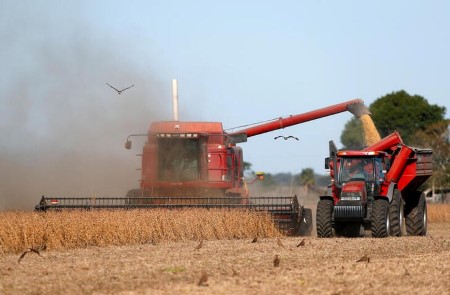Updates with
BUENOS AIRES, Sept 9 (Reuters) – Argentine farmers are expected to harvest 48.8 million tonnes of soy in the 2021/22 season, down from a previous estimate of 49 million, the Rosario Grains Exchange said in a report late on Wednesday.
The country’s 2021/22 corn crop, however, is estimated at between 55 and 56 million tonnes, up slightly versus the exchange’s previous forecast of 55 million, the report said.
Argentina is a leading global wheat supplier, the world’s No.2 corn exporter, and the main global exporter of soy oil and meal. Recently, some farmers have turned to corn over soybeans, however, to confront drought and take advantage of higher profitability.
The Rosario Exchange said the area planted with soybeans in 2021/22, due to ramp up in October, will likely be 16.2 million hectares, cutting an additional 200,000 hectares of planted area from its prior forecast, for a total of 700,000 hectares less than the previous season.
To explain the new cut, the exchange said current profit margins for soybeans were “lower than corn,” and noted falling yields due to “lack of water and the greater tax burden on oilseed.”
In Argentina, soybean exports pay a 33% tax, while shipments of soybean oil and meal are subject to a 31% tax. The tax on corn exports is substantially lower at 12%.
The exchange added 100,000 hectares to its forecast for the 2021/22 corn planting area, for a total of 6.9 million hectares, but noted the estimate does not include the grains used by the producers themselves.
“The storms that began on September 1 and have lasted until today (Wednesday) ended with three months of lack of water in the Pampas region,” the exchange report said, referring to the main agricultural region of Argentina.
The exchange also predicted the season’s wheat harvest would hit 20.5 million tonnes, up slightly from an estimate of 20.1 million.
“For wheat 2021/22 these rains marked a milestone because they leave behind a very different scenario,” the exchange report said, noting particularly high rainfall in key wheat planting areas.
(Reporting by Maximilian Heath; editing by Jason Neely and Alistair Bell)
(([email protected]; +56 9 9138 1047, +56 2 2370 4224))
The views and opinions expressed herein are the views and opinions of the author and do not necessarily reflect those of Nasdaq, Inc.
www.nasdaq.com
